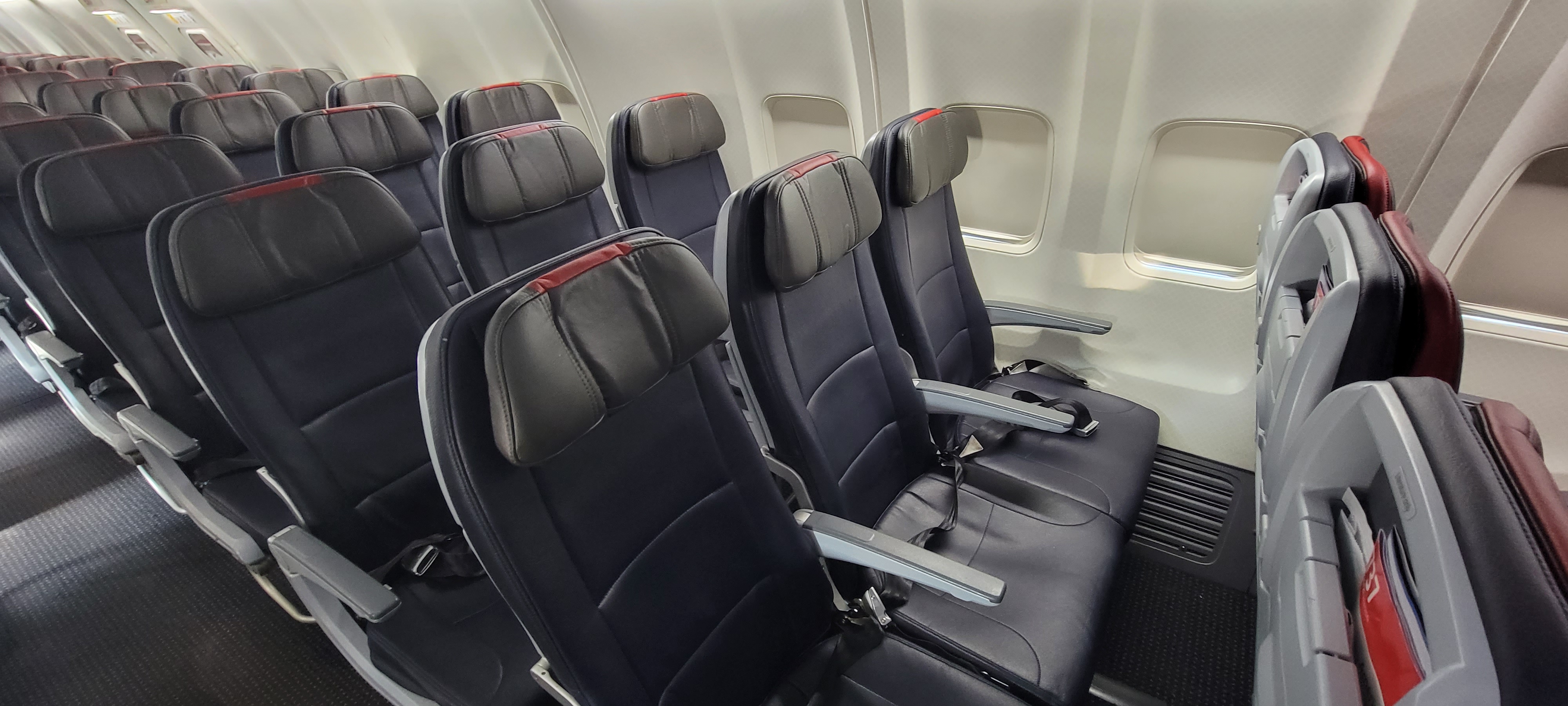Hyatt and American Airlines have had a lucrative partnership for the past five years. Hyatt elites earn points when flying American, and American elites earn miles when staying at Hyatt. That’s in addition to the usual points they earn for their flights and stays.
What’s more, the extra American Airlines miles earned by American’s members with status when staying with Hyatt have counted towards re-qualifying for their AAdvantage status. This all ends next year.
- These changes are a negative for many customers. I’ve had several readers lament that they are loyal to American and Hyatt. They’re among the best customers for both travel companies – already earning AAdvantage Executive Platinum and Hyatt Globalist.
- And the new program, which offers modest status (e.g. Hyatt Explorist and AAdvantage Platinum, plus status for a day options), leaves little for them that they do not already have.

American Airlines
The thing to understand about these changes is that they are a massive cost savings to the programs. Awarding points for every stay and flight that a linked member completes is expensive. And they do not want to spend money marketing to the customers that they already have. AAdvantage Executive Platinums and Hyatt Globalists (like me) have been getting extra points from both companies for things we’re already doing, staying with Hyatt and flying American.
Instead of spending marketing dollars on already-engaged members, it’s the members themselves who will be funding much of the partnership.
- Redeeming Hyatt points for status, that cost comes out of the member account not from the program
- Redeeming AAdvantage miles for Hyatt stays, that cost comes out of the member account not from the program
- And when selecting a partner benefit as a benefit choice saves the program from giving you one of the other available choices (which comes at a cost)

Park Hyatt Dubai
It’s now the members who are the ones paying for the relationship. And the relationship is realigned towards accomplishing the actual goals that American and Hyatt have. Clearly the changes don’t benefit those who already have Hyatt and American status, but that is the point.
They don’t want to spend marketing dollars on current customers. Hyatt wants access to engaged American Airlines customers to fill incremental rooms (and build new customer relationships). American wants more Hyatt regulars on their planes that they aren’t already getting (and, ultimately, signing up for their co-brand credit card).

Seabird Resort Grand Estate Suite
The American Airlines – Hyatt partnership isn’t about ‘rewarding us.’ The partnership is about looking for new customers for each brand. And these changes are designed to align marketing dollars with corporate objectives.


Hyatt made me do exactly what you said.
Fly AA when I wouldn’t have.
This is for people like me, Hyatt 100+ nights and UA, 1k with 30k+ PQDs
I’ll never get UAGS being a road warrior and 20 plus points are trivial for 3k PQD
So on long flights I’m still taking UA to get to 2MM but on expensive short flights I’m happy to give AA a shot due to Plat Pro status
Ah, I understand: The idea is to disincentivize people from buying your product by making it less rewarding when they do so. I must’ve missed the class in business school where they teach you that driving away loyal customers who spend money with you is a great idea.
@ Gary — Indeed. It drove exactly zero incremental revenue from my household. It was just a give away.
@Christian – I seriously doubt this change will impact your behavior in any way which is exactly the point of Gary’s article. BTW if you went to business school you would know there is a higher premium on attractive new customers instead of “rewarding” ones you already have.
Frankly very smart move by AA and Hyatt to better align the incentives.
I agree with you Gary, but AA should of at least kept giving LPs for Hyatt revenue stays. That doesn’t cost them anything. And if it does, well have a reasonable cap (say 20k LPs).
@AC – Gaining new loyal customers is a huge business expense. Much better to spend a little more to keep the ones generating revenue and profit for you than to start off from scratch. This is a pretty elementary business concept so if you have any knowledge of the business world I’m surprised you’re not familiar with it. My business has grown for over twenty years predicated on that retaining loyal customer premise so there must be some validity to what I learned.
This move will absolutely cause me to spend less with American and Hyatt so it’s tough to see how it’s a net win unless the majority of customers actually want less for their money.
Hmmm. I am not so certain that the writer (yes, Gary), understands the value of retaining customers and increasing ARR (Annual Recurring Revenue), and increasing overall LTV (Lifetime Value). Alas, most companies don’t know this either, and that it is cheaper to spend money on your existing clients to retain them than get new customers.
While I am Titanium (Lifetime PLT) with Marriott (and EXP with AA), this program did sway me towards Hyatt properties versus other brands when Marriott properties were less desirable. I hadn’t considered Hyatt over other alternatives before this program. That won’t be an incentive going forward.
It attracted the wrong type of customer, i.e. those who are so cheap thar chase every single point. These are typically the least profitable (if not outright unprofitable) customers.
There’s nothing smart about these changes. These same companies that apparently want to chase away their best customers so they can obtain new ones, are the same companies that over leveraged their loyalty programs to banks for billions in USDs. These changes are akin to when properties play games with their “free breakfast” benefit for their most loyal members. It’s more of an annoyance than anything and most high spenders will simply transition their high spending to the programs that benefit them the most.
This may make sense for AA and Hyatt given that it costs them less. They must have calculated the opportunity cost of giving less will not impact their bottom line as people seek other options for travel. The target for this promotion should be the Hyatt loyalists who otherwise were not flying AA, or the AA flyers who were not staying at Hyatt. I fit into the former.
For myself as a Hyatt Globalist, I now will never book another AA flight after January 1st for the rest of my life (other than cashing out the miles I have accrued). They are more expensive than JetBlue with a subjectively equal, but probably worse, product, given AA has no screens in their seat backs.
I was never, and will never be a high flight spender, as I only fly about 2-3 times per year with my family. But I guess the 25k miles I would earn through Hyatt spend (worth about $280-$300) was too much for AA to give to keep me spending $4,000 a year on flights with them. My mileage account will be lighter, but my pockets will be fatter.
Sayonara…
Hysterical — they deliberately a
Lie are and punish the biggest spenders by targeting people that travel twice a year. Yep, that makes perfect sense (deep sarcasm). Democrat math. Stupidity wins again.
No disagrreement here. We can get angry for our loyal airlines/hotels/whatever doing things that are revenue centric, but as much as it makes me sad, if i ran the airline or the hotel chain, i’d do the same thing. Besides the Andy Luten amazing post on his travel blog, but that’s a whole nother subject.
Gary – you do bring up some valid points about retaining existing customers vs attracting new. I agree that attracting new is important, but you don’t take into account customer churn.
As Marriott Titanium (closing quick on lifetime plat), I swapped from Marriott to Hyatt last month entirely due to this partnership. I will make my status challenge, but in absence of this program I’m losing my incentive to stay and not go back.. For the last two months, I’ve stayed at hotels different than my work peers, and generally inconvenienced myself to try out Hyatt. Many a happy hour or nightcap ended and I had to transit back to my hotels.
This program attracted me, but may quickly churn me. Nothing in the new program is going to attract new members.
I am only annoyed because Hyatt has ended multiple partnerships in the last year, MGM? Where is the added value? We lost these program and nothing replaces them.
I am another Globalist who will never go out of my way to book AA again.
To add to the rage-quitting pile-on: World of Hyatt has really been devalued over the last year. I’m cancelling my Hyatt visa card when the AF renewal rolls around. But I never had enough travel to make it to Globalist, so they probably won’t notice.
Like others here have mentioned, I have status in several hotel and airline programs. The reciprocal earning encouraged me to be loyal to both programs. I would often book a hotel that was farther away, less ideal or book a flight that was at less than ideal time to max both programs. Remove that and what incentive do I have to do this with either? If they want to focus on earning new customers, then maybe I’ll focus on earning new status with other brands.